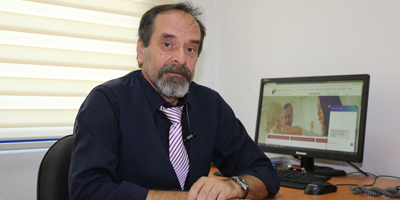EUL Academician Meriç drew attention to the importance of Cancer Rehabilitation

European University of Lefke (EUL) Faculty of Health Sciences Physiotherapy and Rehabilitation Department Head Asst. Prof. Dr. Aydın Meriç made explanations about “Cancer Rehabilitation” and gave detailed information.
Meriç said, “Cancer rehabilitation is to help a patient with cancer gain maximum physical, social, psychological and occupational functions within the limits determined by the disease and the treatments”. He pointed out that with exercise programs in cancer rehabilitation, it is aimed to protect the musculoskeletal system tone, to reduce the effort spent by the individual with respiratory exercises, to minimize the level of fatigue, and to increase the quality of life in adult and pediatric patients, in various types of cancer, starting from the early period.
Stating that rehabilitation increases the quality of life, Meriç stated that rehabilitation can be applied at every stage of the disease and cancer rehabilitation is divided into 4 stages as preventive, restorative, supportive and palliative treatment.
Meriç: Cancer rehabilitation is divided into 4 stages as preventive, restorative, supportive and palliative treatment.
Meriç explained 4 phases in the continuation of his statement; “In the preventive rehabilitation phase, it is aimed to reduce the severity of the problems with the education of the patient before the problems and loss of function occur or increase. The supportive stage is characterized by the continuation of the disease and the need for treatment, and changes in functional abilities. The aim of rehabilitation at this stage is to limit the functional changes and reduce the problems caused by the loss of function. The patient’s needs differ in this phase. Cognitive rehabilitation in brain tumors, walking exercises applied after limb sparing surgery in bone and soft tissue tumors, balance rehabilitation are examples of supportive rehabilitation.
Restorative stage in cancer rehabilitation; It aims to overcome the problems caused by the disease or treatment, to return to the functional level before the disease and to gain maximum capacity. It is among the goals for people whose treatment has been completed to regain their independence and return to work. While making the treatment plan in this phase, a realistic goal should be determined for the patient and their family and an acceptable program should be made. The time required for this phase varies with the patient’s age, mental status, motivation, and physical problems. Psychological adaptation also plays an important role. Palliative rehabilitation is for patients in the terminal phase of the disease. This period is characterized by the progression of loss of function. The aim of palliative treatment is to reduce or eliminate the complications of the disease, and to relieve the patient and his family physically and emotionally. Treatment for symptoms, especially pain, has an important place. Despite the increase in addiction in this period, independence in certain functions and family training on home care should be provided.
Meriç said, “54 percent of patients diagnosed with cancer need rehabilitation. Because there are many conditions that cause functional disability and require rehabilitation in cancer patients. There may be general problems such as fatigue, weakness, loss of condition, pain, as well as walking problems, self-care problems, communication problems, dysphagia, lymphedema, pressure sores, paraneoplastic neuromuscular syndromes, brain metastasis, spinal cord metastasis, osteoporosis, which are more prominent in specific cancer types. Bladder-bowel dysfunction, sexual dysfunction or side effects related to chemotherapy and radiotherapy may also be seen.
Meriç said, “A multidisciplinary rehabilitation program that is individually planned, has realistic goals, provides the active participation of the patient, and has an education and psychosocial counseling element, increases the functional abilities and quality of life of cancer patients by reducing their complaints,” Meriç continued as follows; “At every stage of rehabilitation, the physical, emotional, sexual, social and occupational needs of the person should be determined and the treatment should be planned according to the person. With exercise programs in cancer rehabilitation, it is aimed to protect the musculoskeletal system tone, to reduce the effort spent by the individual with respiratory exercises, to minimize the level of fatigue, and to increase the quality of life in adult and pediatric patients, in various types of cancer, starting from the early period. In individuals diagnosed with cancer, exercise programs that include the principles of personal loading in the first period are aimed at preserving and maintaining physical functions. In individuals diagnosed with cancer, exercise programs that include the principles of personal loading in the first period are aimed at preserving and maintaining physical functions. In the progressive period when cancer treatments continue, the main purpose of physiotherapy and rehabilitation practices is to increase the quality of life of the individual. Treatment programs are planned with the aim of reducing the level of fatigue, minimizing pain, optimal participation in daily life activities and maximum independence. Muscle strengthening exercises, low-intensity aerobic exercises (such as walking, cycling), strengthening the abdominal muscles and back muscles in patients with risk for spinal fracture. Balance exercises are recommended to prevent the risk of falling.
Meriç stated that respiratory exercises, neck and arm muscle strengthening exercises and aerobic exercises are applied to the patients in lung tumors, and neck joint range of motion exercises and stretching exercises in all directions, strengthening of the muscles in the back of the neck and posture training are applied in patients who receive radiotherapy to the head and neck region.
Meriç concluded, “There are important findings showing that exercise provides significant benefits in patients with advanced disease and slows down functional declines. First of all, exercise suppresses many of the patients’ symptoms, including shortness of breath and fatigue. Controlled aerobic fitness exercises show significant benefits not only in symptom weight but also in psychological recovery and quality of life. Satisfactory and effective practices are needed to improve the functional status and quality of life of cancer patients at the earliest stage.
